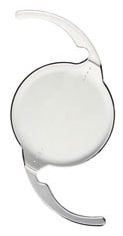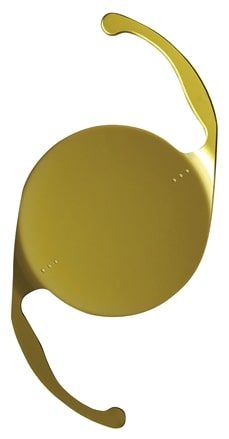
Multifocal Lenses: Youthful Vision for Cataract Patients
Replacing a patient’s cataract-clouded natural lens with an artificial intraocular lens has long been an incredibly successful surgery that delivers amazing vision improvement. But there used to be only a single decision to make. Patients would decide whether they wanted their replacement IOLs, which were only available in a monofocal vision range, to focus on distance vision or up-close vision. The patient would then use eyeglasses to correct for the other vision range.
That all began to change in the late 1980s with the debut of the first generation of multifocal IOLs. These technologically advanced lenses now allowed for a clear vision at a variety of distances, from up close to distance. In the 35 years since that debut, technology has continued to evolve. Today, there are a variety of options for excellent vision with cataract replacement IOLs. There are multifocal IOLs (which use different areas of the lens for different distances), accommodating IOLs (which flex like your natural lens does to allow focus across all distances), and toric IOLs that correct for astigmatism while also correcting refractive errors. Today’s awesome IOLs even correct for presbyopia, the near-universal condition that makes it hard for people over 40 to focus on up-close viewing, hence the need for reading glasses.
At Cape Fear Cataract & Cornea with Dr. Brian Groat, we call these “lifestyle lens options.” The array of choices can be daunting for patients, but we help walk you through the pluses and minuses of each IOL lens option. For many patients, these lens choices allow them to live without eye glasses forevermore.
What Are Multifocal Lenses?
The TECNIS® Multifocal and Alcon ReSTOR® lenses represent breakthrough technology because of their unique optic design which may allow patients to experience the highest level of freedom from glasses.

Advantages of Multifocal Lenses
Multifocal IOLs and accommodating IOLs are called premium IOLs because they cost more than monofocal IOLs. But most patients feel the benefits of these IOLs are more than worth the extra cost.
Premium IOLs allow you to see at all distances without glasses. This means you won’t have to constantly have glasses with you to correct for whichever option you chose not to correct with monofocal IOLs. Premium IOLs also now can correct for astigmatism and presbyopia, actually improving the patient’s refractive vision from what it was before the cataracts were removed.
What Are the Disadvantages to Multifocal or Accommodating IOLs?
Premium IOL options, or lifestyle lens as we call them at Cape Fear, are really an awesome improvement in vision correction for cataract patients, but they aren’t perfect. There are a couple of issues involved with multifocal and accommodating IOLs that may or may not be an issue for you.
With multifocal IOLs, distance vision and up-close vision are quite good, usually in the 20/20 range. Intermediate vision is acceptable, but some patients need to make adjustments, such as sitting closer to their computer screen. Also, about one-quarter of multifocal IOL patients notice glare and haloes around lights at night. This can interfere with the person’s ability to drive at night. Most patients, however, find that they get used to this phenomenon with time and the glare and haloes become less obvious. It should be noted that this doesn’t occur only with multifocal IOLs: 7-8 percent of patients with monofocal lenses also have glare and haloes.
Because accommodating IOLs move on the patient’s eyes to change focal length, they can have some disadvantages based on the patient’s individual healing position. The precise position the accommodating IOL ends up in cannot be accurately predicted preoperatively and depends on each individual eye’s healing mechanism. It can vary its final position from front to back, affecting either the quality of distance or up-close vision. This occurs in about 20 percent of patients where the accommodating IOL heals into a position slightly away from the average location. In most of these cases, however, LASIK or PRK refractive surgery can be performed to improve the range of unaided vision available. The patient can always wear a mild correcting pair of glasses for certain tasks, as well.
How Do I Know Which Intraocular Lens Will Be Right for Me?
At Cape Fear Cataract & Cornea, we love educating our patients about the different options they now have with cataract surgery. There are differences between multifocal and accommodating IOLs that can help you make the choice one way or the other.
But you really can’t go wrong with either choice. And now you can add astigmatism correction to both multifocal and accommodating IOLs.
Are These New Lifestyle Lens IOLs Permanent?
Once the cataract-clouded natural lens is removed it has to be replaced with an artificial intraocular lens. No matter which IOL you choose, be it monofocal, multifocal, or accommodating, these are permanent lenses. They will not cloud. They will not degrade in any way. They are meant to last for the rest of the patient’s life, and they will provide crystal clear vision during that time.
Results of Multifocal Lenses
During some of the clinical trials in the US, the results were impressive:
- Nearly 9 out of 10 patients NEVER wear glasses
- Nearly 90% of patients are able to function comfortably without glasses at ALL distances
- Nearly 94% would choose to have the procedure done again
What Are the Different Types of Lifestyle Intraocular Lenses Available Today?
At Cape Fear, Dr. Groat and our team will take you through the expanding options when it comes to lifestyle lens choices. These are known as premium intraocular lenses. Here’s a breakdown of the premium intraocular lens choices:
Multifocal IOLs
Multifocal IOLs have focal zones, or rings, that allow you to see clearly at both near and far distances. While these IOLs may not completely remove your need for glasses at all times (such as extended periods of reading), they will dramatically reduce the need. Some studies have shown that multifocal IOLs provide better near vision than accommodating IOLs, but they are also more likely to cause glare or mildly blurred distance vision as a tradeoff.
Accommodating IOLs
Like multifocal IOLs, accommodating IOLs expand the range of focus to both near and far, but they do this in a different fashion. Accommodating IOLs have what are called “haptics” on the ends. These supporting legs hold the IOL in place inside the eye. This haptics is flexible, and they allow the accommodating IOL to move forward slightly when you look at near objects, which increases the focusing power of the eye enough to provide good near vision.
Toric IOLs
Toric IOLs help those with astigmatism. These are the most recent addition to premium IOLs. They correct for astigmatism as well as nearsightedness or farsightedness. They do this through different powers in different meridians of the lens. These IOLs have alignment markings on the peripheral part of the lens that enables Dr. Groat to adjust the orientation of the IOL inside the eye for optimal astigmatism correction.
The development of toric IOLs has basically removed the need for what is called limbal relaxing incisions. These were formerly the way astigmatism could be reduced during cataract surgery. These small incisions were made at opposite ends of the cornea. When they healed, the cornea would become more spherical in shape compared to the more oval shape of a cornea with astigmatism.

Toric Intraocular Lenses: (Astigmatism Correcting)
Correcting Astigmatisms With Intraocular Lenses
Many eyes have an astigmatic shape. Much like a football surface has two curves in comparison to a basketball surface which has only one uniform curvature, an eye with astigmatism has more than one shape of optical curvature. This results in blurring of images at all distances unless corrected by glasses, contacts, or surgery. Astigmatism is now routinely corrected simultaneously with cataract surgery using toric (astigmatism correcting) lenses.

Treatment for Moderate to Severe Amounts of Astigmatism
Moderate to severe amounts of astigmatism are best treated with a lens implant such as the TECNIS® Symfony or AcrySof® IQ toric lenses.
Treatment for Lower Amounts of Astigmatism
Lower amounts may be treated with precise astigmatism correcting laser incisions using the LenSx laser.
What Are the Risks Involved With Multifocal and Accommodating IOLs?
The risks involved with these technologically advanced IOL options are the same as with all cataract surgeries. But these are incredibly low-risk procedures. In fact, cataract surgery is the most successful surgery performed around the world.
Discussed as potential disadvantages above, with multifocal IOLs the patient may not have the perfect intermediate vision, and about one-fourth of patients notice glare and haloes around lights at night. With accommodating IOLs (also discussed above), there is a chance that the lens won’t heal in the absolute correct spot, so there can be some loss of quality in distance or up-close vision.
Are Multifocal and Accommodating IOLs Considered Safe?
These lens options have all been tested and approved for cataract surgery by the FDA and other health organizations around the world. They are safe and effective for restoring clear vision at all distances, usually improving the patient’s quality of vision from their pre-cataract days.
Patient Testimonials:
"Dr. Groat is a very special person and surgeon. Dr. Groat has the ability to explain complex medical terms in everyday English and he wants you to understand your individual sight problem before your surgery.
His skills go so far beyond being an excellent surgeon. I had no discomfort during or after surgery. I have 20/20 vision at 66 years old. His office staff is a group of amazing folks that only a great doctor could acquire."
- P.B.
- C.P.
Schedule a Consultation With Dr. Brian Groat
Dr. Groat, the surgeon of Cape Fear Cataract & Cornea, is highly experienced in the use of these premium intraocular lenses. Call us at 910-769-4590 to schedule your consultation today.


